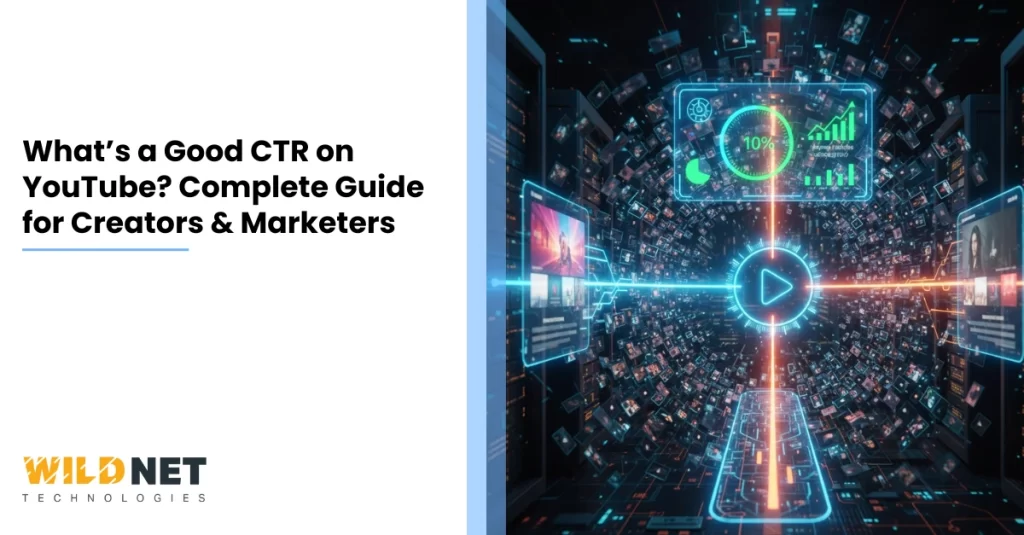When growing a YouTube channel, one of the most critical metrics creators look at is CTR (Click-Through Rate). A high CTR means viewers find your title and thumbnail irresistible enough to click. A low CTR means your content isn’t capturing attention, even if YouTube shows it to many people.
So, what’s a good CTR on YouTube?
And how can you improve it consistently?
In this blog, we’ll explain the meaning of CTR, what YouTube considers a “good” CTR, ideal benchmarks, how to analyze performance, common mistakes creators make, and strategies to increase your CTR.
What Is CTR on YouTube?
CTR (Click-Through Rate) on YouTube is the percentage of viewers who click your video after seeing it on their feed, recommendations, homepage, or search results.
Formula:
CTR = (Clicks ÷ Impressions) × 100
Example:
If your video receives 10,000 impressions and 600 clicks → your CTR = 6%.
What’s a Good CTR on YouTube? (Primary Keyword)
Generally, a good YouTube CTR is between 4% and 10%.
However, CTR varies depending on:
- Audience type
- Niche
- Video topic
- Thumbnail quality
- Competition
- Traffic source
According to YouTube Creator Academy, most channels fall between 2% and 10% CTR, with 5–8% considered above average.
What’s a Good CTR YouTube? (Search Variant)
When users ask “what’s a good CTR YouTube”, they’re usually looking for a simple benchmark:
YouTube CTR Benchmarks:
| CTR % | Performance |
| Below 2% | Needs improvement |
| 2–4% | Average |
| 4–6% | Good |
| 6–10% | Excellent |
| 10%+ | Viral potential (common in first 24 hours but usually normalizes over time) |
A CTR above 10% is possible, especially for:
- New videos
- Narrow niche topics
- Strong thumbnails
- Highly targeted audiences
But CTR typically drops as YouTube expands your reach.
What’s a Good YouTube CTR for Different Traffic Sources?
CTR changes based on where people see your video:
1. YouTube Search Results
CTR: 6% – 14%
Because users are actively searching.
2. Suggested Videos
CTR: 4% – 8%
These appear next to related videos.
3. Homepage / Browse Features
CTR: 2% – 6%
More competitive, broader audience.
4. External Traffic
CTR: 10% – 20%
Social media audiences are more familiar with you.
What’s a Good CTR for YouTube Shorts?
Shorts CTR is not shown publicly, but Shorts Swipe Rate works similarly.
A good Swipe Rate is 30% or lower (meaning viewers are watching, not skipping).
Why Is CTR So Important for YouTube Growth?
YouTube uses CTR + Watch Time + Viewer Satisfaction to decide:
- Whether to recommend a video
- How often it should appear on the homepage
- Whether it deserves long-term visibility
A high CTR tells YouTube:
“People want to watch this video — show it to more users.”
A low CTR signals:
“This video isn’t attracting interest — limit exposure.”
This is why CTR is one of the strongest ranking factors on YouTube.
How to Analyze CTR on YouTube (CTR Analysis Guide)
To understand your CTR properly, look at:
1. Impressions vs. Clicks
High impressions + low clicks = your title/thumbnail needs work.
2. CTR by Traffic Source
Check which platforms bring the highest clicks.
3. CTR by Device Type
Mobile CTR < Desktop CTR
because mobile screens show more competition.
4. CTR Over Time
CTR is usually high in the first 48 hours, then stabilizes.
Top Reasons Why Your YouTube CTR Is Low
- Weak or confusing thumbnail
- Generic titles
- Irrelevant topic
- Low emotional impact
- Too much text on thumbnail
- Competitors with stronger visuals
- Poor color contrast
- Misleading content
- Low brand recognition
- Cluttered design
Fixing these can dramatically boost your CTR.
How to Increase CTR on YouTube (Proven Tips)
Here’s how to improve CTR using practical and creator-tested methods:
1. Create High-Contrast Thumbnails
Bright colors and strong contrast catch the eye.
Avoid light grey, pale blue, and washed-out images.
Best performing colors:
- Yellow
- Red
- Black
- Green
- Blue
2. Use Emotion-Driven Faces
Thumbnails with human expressions get higher CTR because:
- People connect emotionally
- Faces create curiosity
- Expressions tell a story
3. Keep Text Short (2–4 Words)
Your thumbnail text should be:
- Bold
- Big
- Clear
- Easy to read on mobile
Examples:
- “DON’T TRY THIS”
- “TIKTOK SECRET”
- “BEST SEO TIP”
4. Write Curiosity-Powered Titles
High CTR titles must include:
- Curiosity
- Clarity
- Benefit
- Specific numbers
- Power words
Examples:
- “How I Gained 10,000 Subscribers in 30 Days”
- “This YouTube Strategy Still Works in 2025”
5. Avoid Clickbait
Clickbait increases clicks but reduces:
- Retention
- Satisfaction
- Recommendations
Use ethical curiosity instead.
6. Improve Topic Selection
CTR isn’t just thumbnails — it’s topic relevance.
Choose topics your audience already wants.
Use tools like:
- YouTube Analytics
- Google Trends
- TubeBuddy
- VidIQ
7. A/B Test Thumbnails
YouTube now allows testing multiple thumbnail versions.
Creators have seen 15–40% CTR improvement.
8. Focus on the First 24 Hours
YouTube uses early CTR to determine whether a video should be pushed.
Boost early CTR by:
- Community posts
- Shorts teasers
- Instagram Stories
- WhatsApp shares
Ideal CTR by YouTube Channel Size
| Channel Size | Good CTR % |
| 0–1K subs | 6–12% |
| 1K–10K subs | 5–10% |
| 10K–100K subs | 4–8% |
| 100K–1M subs | 3–7% |
| 1M+ subs | 2–6% |
Large channels often have lower CTR because they reach broader audiences.
Does Higher CTR Always Mean Success?
Not always.
YouTube cares about CTR + AVD (Average View Duration).
High CTR + Low AVD = bad
Low CTR + High AVD = good
High CTR + High AVD = viral potential
Your goal:
More clicks + longer watch time = maximum growth.
Conclusion
So, what’s a good CTR on YouTube?
In most cases:
- 4%–10% is considered good
- 6%+ is excellent
- 10%+ has viral potential
CTR varies by niche, topic, and traffic source — but improving your thumbnail, title, and storytelling can dramatically boost your performance.
If you want to grow your channel faster, focus on:
- Better topic selection
- Clear emotional visuals
- Strong curiosity hooks
- A/B testing and performance analysis
Small changes can lead to huge improvements in YouTube impressions, clicks, and overall channel growth.
Understanding what a good CTR on YouTube is essential for creators, brands, and marketers who want to grow consistently on the platform. While a CTR between 4% and 10% is generally considered good, long-term success depends on more than just clicks — it requires compelling thumbnails, relevant topics, strong viewer retention, and continuous optimization.
For businesses and creators looking to improve YouTube performance, partnering with a professional agency can make a significant difference. Wildnet Technologies, with its comprehensive Digital Marketing Services, helps brands analyze video performance, optimize thumbnails and titles, implement data-driven strategies, and improve overall visibility across YouTube and other digital platforms. With the proper guidance and optimization framework, your videos can attract higher engagement, better CTR, and sustained channel growth.
FAQs
1. What’s a good CTR on YouTube?
A good CTR is typically between 4% and 10%, depending on niche and traffic source.
2. Can a YouTube video have 15% CTR?
Yes. High CTR is common in the first 24 hours or with highly targeted audiences.
3. Why is my CTR dropping?
As YouTube expands your reach to new audiences, CTR naturally declines.
4. Does CTR affect YouTube ranking?
Yes. YouTube uses CTR + Watch Time to determine recommendations.
5. How do I increase my YouTube CTR fast?
Improve thumbnails, shorten text, use emotional visuals, write curiosity-driven titles, and A/B test.
Read More
- How To Increase Subscribers On Youtube?
- How To Rank YouTube Videos?
- Best Time to Upload Shorts on YouTube: A Deep Dive for 2025 Success
- How to Get Transcript of YouTube Video (2025 Guide)
- YouTube SEO Tools: How to Rank Videos on the First Page
- YouTube Video Optimization:Tips To Boost Organic Reach In 2025
- How To Cite A Youtube Video?






